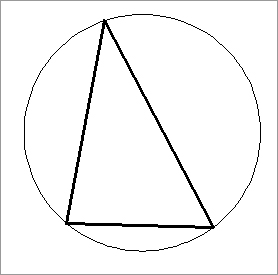A surface in Civil 3D is built on the basis of mathematical principles of planar geometry. Each face of a surface is based on three points within a circumcircle (a circle that passes through each of the vertices of a polygon) forming a triangle and defining a plane (Figure 4-1). Each of these triangular planes shares an edge with another, and a continuous surface is made. This methodology is typically referred to as a triangulated irregular network (TIN), as shown in Figure 4-2. On the basis of Delaunay triangulation, this means that for any given (x,y) point, there can be only one unique z value within the surface (as slope is equal to rise over run, when the run is equal to 0 the result is “undefined”). What does this mean to you? It means surfaces in Civil 3D have two major limitations:
Figure 4-1: Three points defining a plane

Figure 4-2: A triangulated irregular network (TIN)

No Thickness Operations on the basis of solid modeling are not possible. You cannot add or subtract surfaces or look for their unions as you can with a solid that has thickness in the vertical direction.
No Vertical Faces Vertical faces cannot exist in a TIN because two points on the surface cannot have the same (x,y) coordinate pair. At a theoretical level, this limits the ability of Civil 3D to handle true vertical surfaces, such as walls or curb structures. You must take this factor into consideration when modeling corridors, as discussed in Chapter 9, “Basic Corridors.”
Beyond these basic limitations, surfaces are flexible and can describe any object’s face in astonishing detail. The surfaces can range in size from a few square feet to square miles and generally process quickly.
There are two main categories of surfaces in Civil 3D: standard surfaces and volume surfaces. A standard surface is based on a single set of points, whereas a volume surface builds a surface by measuring vertical distances between surfaces. Each of these surfaces can also be a grid or TIN surface. The grid version is still a TIN upon calculation of planar faces, but the data points are arranged in a regularly spaced grid of information. The TIN surface definition is made from randomly located points that may or may not follow any pattern to their location.
